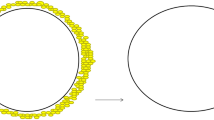Abstract
Background
Rippling and implant edge visibility after breast augmentation depends on several factors. Among the most relevant are breast soft tissue thickness, particularly the retroareolar mammary parenchyma, and implant profile. They were correlates to prevent these occurrences.
Methods
Thirty patients underwent breast augmentation through subfascial dissection involving the pectoralis, serratus, external oblique, and rectus abdominis fascias. The thickness of the retroareolar mammary parenchyma distributed patients into two groups. Group I: patients with thickness equal to or greater than 4.0 cm received high-profile 85% fill round implants. Group II: patients with thickness up to 3.9 cm received extra-high-profile 100% fill round implants. MRI was performed preoperatively and 5 years after augmentation to evaluate breast tissue changes and implant contouring.
Results
Seventeen patients with high-profile implants and thirteen patients with extra-high-profile implants had noticeable improvement of the breasts without the occurrence of rippling or implant edge visibility. A natural appearance of the breast, increased mammary cone, balanced upper and lower pole contouring was maintained at 5 years postoperatively. MRI performed 5 years after breast augmentation validated patient clinical outcomes not evidencing implant deformities, or soft tissue thinning, parenchymal atrophy or chest wall deformities.
Conclusions
The adequate correlation between retroareolar mammary parenchyma thickness with high-profile 85% fill and extra-high-profile 100% fill textured round implants was of utmost importance in preventing rippling and implant edge visibility. The wide fascial support, width of the implant smaller than the breast diameter, and soft cohesive gel-filled implants were co-adjuvant factors in preventing rippling and implant edge visibility.
Level of Evidence IV
This journal requires that authors assign a level of evidence to each article. For a full description of these Evidence-Based Medicine ratings, please refer to the Table of Contents or the online Instructions to Authors www.springer.com/00266.








Similar content being viewed by others
References
Brown MH, Shenker R, Silver SA (2005) Cohesive silicone gel breast implants in aesthetic and reconstructive breast surgery. Plast Reconstr Surg 116:768–779
Panettiere P, Marchetti L, Accorsi D (2007) Soft cohesive silicone gel breast prosthesis: a comparative prospective study of aesthetic results versus lower cohesivity silicone gel prosthesis. J Plast Reconstr Surg 60:482–489
Jewell ML, Bengtson BP, Smither K, Perry TA (2018) Physical properties of silicone gel breast implants. Aesthet Surg J. https://doi.org/10.1093/asj/sjy103
Codner MA, Cohen AT, Hester TR (2001) Complications in breast augmentation: prevention and correction. Clin Plast Surg 28:587–595
Pantelides NM, Srinivasan J (2018) Rippling following breast augmentation or reconstruction: aetiology, emerging treatment options and a novel classification of severity. Aesth Plast Surg. https://doi.org/10.1007/s00266-018-1117-y
Tebbetts JB (2002) Breast implant selection based on patient tissue characteristics and dynamics: the TEPID approach. Plast Reconstr Surg 190:1396–1409
Brown T, Brown S, Murphy T (2017) Breast durometer (mammometer): a novel device for measuring soft-tissue firmness and its application in cosmetic breast surgery. Aesth Plast Surg 41(2):265–274
Sun J, Um D, Liu C, Ji K, Chen L, Liu W, Luan J (2016) Scar assessment after breast augmentation surgery with axillary incision versus inframammary fold incision: long-term follow-up in Chinese patients. Aesth Plast Surg 40(5):699–706
Sampaio Goes JC, Landecker A (2003) Optimizing outcomes in breast augmentation: seven years’ experience with the subfascial plane. Aesth Plast Surg 27:178–184
Slavin SA (2010) Discussion: high-and extra-high-projection breast implants potential consequences for patients. Plast Reconstr Surg 126(6):2163–2164
Weum S, de Weerd L, Kristiansen B (2011) Form stability of the style 410 anatomically shaped cohesive silicone gel-filled breast implant in subglandular breast augmentation evaluated with magnetic resonance imaging. Plast Reconstr Surg 127(1):409–413
Smiles J, McGrane A (2002) Correlação e Regressão. In: Smiles J, McCrane A (eds) Estatística Aplicada à Administração com Excel. Editora Atlas, São Paulo, pp 114–142
Emerson JW, Green WA, Schoerke B, Crowley J, Cook D, Hofmann H, Wickham H (2013) The generalized pairs plot. J Comput Graph Statist 22(1):79–91
Nava MB, Rancati A, Angrigiani C, Catanuto G, Rocco N (2017) How to prevent complications in breast augmentation. Gland Surg 6(2):210–217
Friendly M, Denis D (2005) The early origins and development of the scatterplot. J Hist Behav Sci 41(2):103–130
Graf RM, Bernardes A, Rippel R, Araujo LR, Damasio RC, Auersvald A (2003) Sub- fascial breast implant: a new procedure. Plast Reconstr Surg 111(2):904–990
Duteille F, Perrot P, Bacheley M-H, Stewart S (2017) Eight-year safety data for round and anatomical silicone gel breast implants. Aesthet Surg J 2(4):1–10
Tebbets JB, Teitelbaum S (2009) High- and Extra-High Projection Breast Implants: potential Consequences for Patients. Plast Reconstr Surg 126(6):2150–2159
Largent JA, Reisman NR, Kaplan HM, Oefelein MG, Jewell ML (2013) Clinical trial outcomes of high- and extra-high-profile breast implants. Aesth Surg J 33(4):529–539
Acknowledgements
“To the cadavers of selfless dedication”.
Author information
Authors and Affiliations
Corresponding author
Ethics declarations
Conflict of interest
No financial support or benefits have been received by the author or any co-author to accomplish this manuscript.
Ethical Approval
All procedures performed in this study involving humans participants were in accordance with the ethical standards of the ACA - Institute of Assistance in Plastic Surgery of São Paulo research committee and with the 1964 Helsinki Declaration and Medical Research Involving Human Subjects and its latter amendments or comparable ethical standards.
Rights and permissions
About this article
Cite this article
Abramo, A.C., Scartozzoni, M., Lucena, T.W. et al. High- and Extra-High-Profile Round Implants in Breast Augmentation: Guidelines to Prevent Rippling and Implant Edge Visibility. Aesth Plast Surg 43, 305–312 (2019). https://doi.org/10.1007/s00266-018-1264-1
Received:
Accepted:
Published:
Issue Date:
DOI: https://doi.org/10.1007/s00266-018-1264-1




